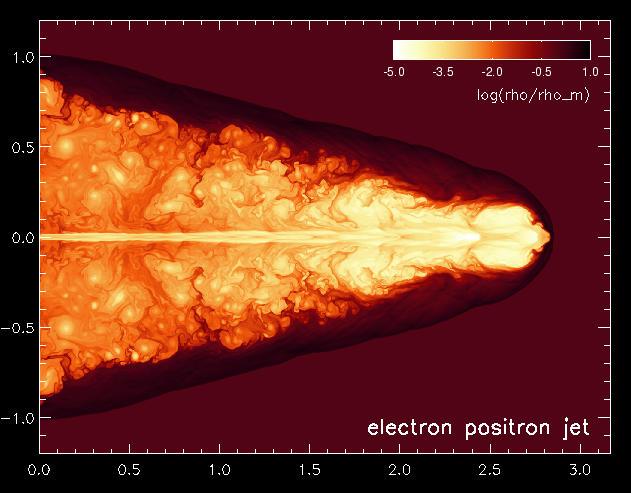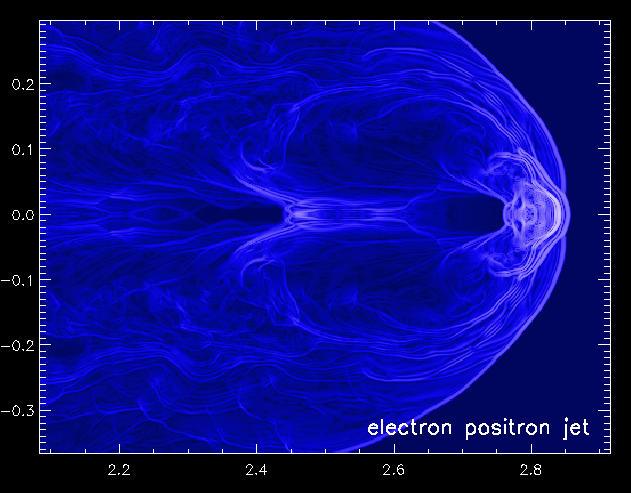Longterm Evolution of Extragalactic Jets |
Extragalactic jets are relativistic (i.e. moving with a velocity near the speed of light) gas flows that are generated in the centers of active galaxies. During their lifetimes of up to 100 million years they transport tremendous amounts of energy up to millions of light years into intergalactic space. At the jet head the kinetic energy of the beam is dissipated and partly converted to radiation, which can be seen in radio telescope images as 'radio lobes'. Little is still known about the process by which these jets are generated. But it is very likely that accretion of matter onto a gigantic black hole in the center of the galaxy provides the energy needed to power the jets. There are several mechanisms that can produce a relativistic jet, and these mechanisms would lead to different compositions of the jet. Knowing whether the jet consists of electrons and protons or of electrons and positrons would provide information about the formation process of the jet.

|
| Figure 1: Rest mass density of a powerful (1046erg/s) electron positron jet at an age of 5,3 million years (axis units: 100,000 light years). The relativistic jet drives a bow shock (dark shape) into the intergalactic medium. The beam is surrounded by a turbulent cocoon where jet and ambient material mix. |
At the MPA long term simulations of jets with different compositions are carried out aimed at finding similarities and differences in their evolution and morphology. Comparing radio observations of extragalactic jets with the radio emission computed from simulated jets can provide information about the matter content of the observed jets.

|
| Figure 2: Pressure gradient of a computed jet rendering prominent the head of the jet, the shock waves in the beam and the turbulent cocoon. |
The images presented here and this MPEG movie (4MB) are produced from the up to now longest simulations of relativistic jets (up to 5300 time units corresponding to an age of about 5.3 million years). In order to evolve the jets for such a long time the simulations had to assume rotational symmetry (with respect to the jet axis). Even with this assumption, one jet simulation utilizing 3.6 million computational zones still required about 150 hours of computing time on the NEC SX-5 supercomputer of the Rechenzentrum Garching (RZG). Assuming no symmetry at all the simulation would take about 30 years on the same machine.

|
| Figure 3: This is what one would see if one could observe the simulated jet with a radio telescope. The angle between the line of sight and the jet axis is 45 degrees. Only the high pressure regions around the heads of the jet ('radio lobes') and one of the two jets are visible. Due to the relativistic Doppler and beaming effects the radiation emitted by matter moving towards / away from us is amplified / weakened. This is why one cannot see the counter jet propagating away from us. |
For the range of initial conditions covered by our simulations so far, surprisingly few differences were found concerning the evolution and morphology of the jets, although their composition was very different (pure electron-positron and pure electron-proton jets). Fixing the power and initial speed of the jet as well as the properties of the (homogeneous) ambient medium the development of the jet seems already to be quite well defined. This may not be true, however, for other choices of initial conditions, i.e. additional simulations have to be performed.
L. Scheck,
E. Müller, J.-M. Marti
| MPA-Home |